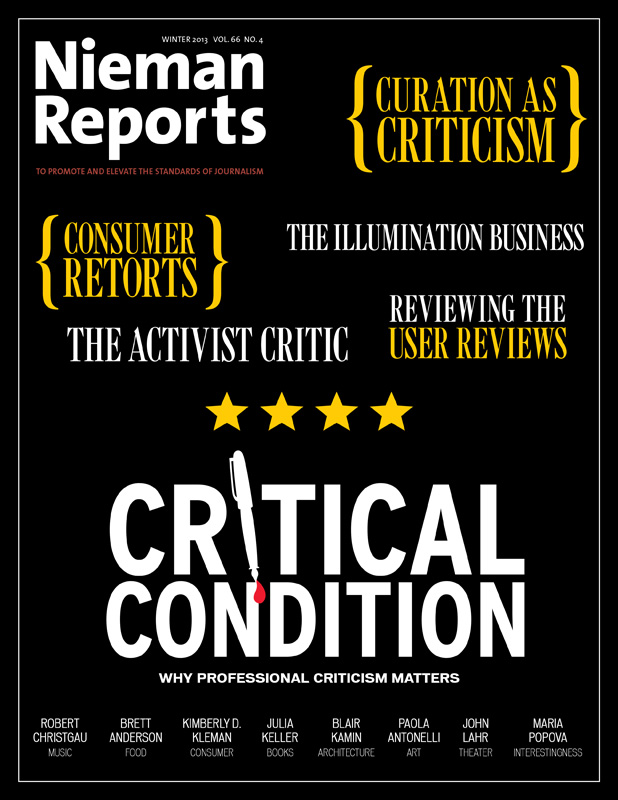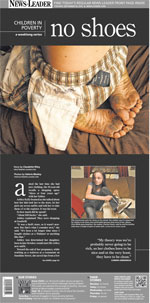Poverty is hardly a new phenomenon in the hardscrabble highlands of Missouri’s Ozarks. But to David Stoeffler, freshly arrived at the helm of the region’s main paper, the Springfield News-Leader, the fact that two out of five families in the area with children under 18 lived below the poverty line seemed like a huge story. “We certainly had covered these issues,” says Stoeffler, who became executive editor in May 2010, “but I would say it was more episodically, and not in any coordinated way.”
16.1%
Percentage of Americans living in poverty (49.7 million total)*
0.2%
coverage primarily about poverty in 50 major news outlets 2007-2012†
Stoeffler decided the paper needed to do more: “My sense was the community needed a little crusading.”
After conversations with community groups and among staffers, the newsroom embarked on a major public service project called “Every Child” examining the range of challenges facing children in the region. There was still a problem, though, the one that plagues all poverty reporting: “What we were trying to do is figure out how could we paint this big broad picture and at the same time not bore everybody to death,” Stoeffler says. “The goal was to try to raise awareness and get people to say, ‘We need to do something about this.’ ”
So for five consecutive days last September, Stoeffler published stories across the entire front page of the print edition and the homepage of the paper’s website. Each day focused on a specific problem: “No home,” “No shoes,” “No food,” “No car,” and “No peace.” Many readers were shocked, saying they had no idea so many area families were living in such desperate circumstances. Some reached out to families that had been featured. Members of the community the News-Leader had initially brought together as an advisory group formed the Every Child Initiative to push for long-term policy changes. “There seems to be momentum toward wanting to do something sustainable and lasting,” Stoeffler says. “We feel like we succeeded in getting the attention of the community.”
Sadly, the News-Leader’s success is an anomaly in the news business. Nearly 50 million people—about one in six Americans—live in poverty, defined as income below $23,021 a year for a family of four. And yet most news organizations largely ignore the issue. The Pew Research Center’s Project for Excellence in Journalism indexed stories in 52 major mainstream news outlets from 2007 through the first half of 2012 and, according to Mark Jurkowitz, the project’s associate director, “in no year did poverty coverage even come close to accounting for as little as one percent of the news hole. It’s fair to say that when you look at that particular topic, it’s negligible.”
Instead, as Tampa Bay Times media critic Eric Deggans notes, at most news organizations poverty comes up sporadically. “Poverty becomes a sort of ‘very special episode’ of journalism that we sort of roll out every so often,” he says.
The reasons for the lack of coverage are familiar. Journalists are drawn more to people making things happen than those struggling to pay bills; poverty is not considered a beat; neither advertisers nor readers are likely to demand more coverage, so neither will editors; and poverty stories are almost always enterprise work, requiring extra time and commitment. Yet persistent poverty is in some ways the ultimate accountability story—because, often, poverty happens by design.
“Poverty exists in a wealthy country largely as a result of political choices, not as a result of pure economics,” argues Sasha Abramsky, a journalist whose upcoming book is called “The American Way of Poverty.” “The U.S. poverty rate is higher than most other developed nations, and the only way you can square that is there are political choices being made—or not being made—that accept a level of poverty that most wealthy democracies have said is unacceptable. We make these policy choices that perpetuate poverty, and then because poverty is so extreme, it becomes impolite to talk about.”
The media could try to force the issue but it doesn’t—at least not anymore, according to Philip Bennett, managing editor of PBS’s Frontline public affairs series: “There are basic questions about the way the country is today that aren’t being addressed by the journalistic institutions that used to address them.”
The rise (and fall) of the Occupy movement, along with data about the increasingly skewed distribution of wealth and income in the United States, have led to greater interest in inequality. “There’s been lots of really good stuff written about inequality, probably more in the last few years than in the previous 20,” says Jason DeParle, who’s covered poverty policy for The New York Times for 23 years. But much of the debate over inequality has focused on the excesses of the rich rather than the deprivations of the poor.
DeParle also notes that one frequent excuse for ignoring poverty is increasingly anachronistic. “We have tended to congratulate ourselves as a country that ‘OK, there’s more poverty, but that’s because there’s also more fluidity in our society,'” he says. But that’s just not true anymore. Recent surveys show that Americans now have less economic mobility than Western Europeans. For instance, one study found that 42 percent of Americans raised in the bottom quintile of family income remain stuck there as adults, compared to 30 percent in the historically class-bound United Kingdom. For Bennett, the key unaddressed question is: Has America become a less fair society? “This is a major question of American life,” he says. “It’s part of our political divide in a really important way. [And yet it] is not receiving the kind of sustained, imaginative, aggressive coverage that it deserves. Shouldn’t journalists—and not just one or two—be organizing themselves en masse to ask that question?”

Homeless camp in Denver, 1983. Photo by Michael S. Williamson, from “Someplace Like America: Tales From the New Great Depression”
One way to address the question is to confront pernicious myths about poverty. “The reason why people believe that ’47 percent nonsense’ [Republican presidential candidate Mitt Romney’s leaked comment characterizing 47 percent of the population as “dependent upon the government”] that Romney was swinging is because they don’t know the working poor,” says Deggans, who is also author of “Race-Baiter: How the Media Wields Dangerous Words to Divide a Nation.”
Despite stereotypes of “the lazy poor,” for example, more than a third of adults in poverty have jobs; they just don’t earn enough to support their families. According to the Economic Policy Institute, 28 percent of workers nationally earn less than $11 an hour. Even working full time year-round, that still leaves a family of four below the poverty line.
10,489
number of presidential campaign stories carried by 8 major print, broadcast news outlets, Jan.-June 2012 *
17
number of those campaign stories that were substantively about poverty
Modern low-wage workplaces can make for gripping stories. Noting Wal-Mart’s promise to hire any recent honorably discharged veteran, Columbia University journalism professor Dale Maharidge suggests reporters follow one of those soldiers around for a few days. Half of Wal-Mart’s more than one million U.S. workers make less than $10 an hour. “See how they cope on $8 or $9 an hour,” says Maharidge, author of “Someplace Like America: Tales From the New Great Depression.” Then consider the Walton family fortune, estimated to be more than $80 billion. “Look at how much money they’re making versus how much their workers are making, through this soldier,” Maharidge suggests.
There are also opportunities for business reporters to broaden questions beyond stock prices and acquisitions. Mimi Corcoran, director of the Special Fund for Poverty Alleviation at the liberal Open Society Foundations, urges journalists to grill CEOs about their companies’ compensation plans and the ratio between what their employees make and their own income. “What are you doing to provide livable wages? What’s the appropriate balance between return on income versus what you’re doing to support your workforce?” Corcoran suggests as model questions.
RELATED ARTICLE
“Exposing the Forces that Grind People Down”
– Dan Froomkin
Gary Rivlin, author of “Broke, USA: From Pawnshops to Poverty, Inc.—How the Working Poor Became Big Business,” points reporters to the businesses (payday lenders, pawnshops and check cashers) that profit from poverty. “Poor people don’t just necessarily happen. The poor have a lot of help staying poor,” he says. Rivlin and Barbara Ehrenreich, another writer with a long history of covering poverty, recently helped found a nonprofit group, the Economic Hardship Reporting Project, to encourage precisely that kind of coverage.
There’s also a wealth of stories in anti-poverty programs. “You always hear, ‘We waged a war on poverty and poverty won,'” says Greg Kaufmann, who covers poverty for The Nation. But the safety net has caught a lot of people who otherwise would have fallen much further, he points out: “It’s like saying the Clean Water Act didn’t work because there’s still water pollution.”
Indeed, one of the most overlooked stories of the decade may be the effects of anti-poverty measures that were part of the 2009 Recovery Act. “They had huge effects; they got virtually no attention,” says Michael Grunwald, a Time reporter and author of “The New New Deal: The Hidden Story of Change in the Obama Era.” The provisions in the stimulus represent the biggest anti-poverty effort since President Johnson’s Great Society in the 1960s.
In addition to expanding anti-poverty programs, the White House and Democrats in Congress made a concerted effort “to really do some innovative—and ultimately, in some areas, remarkably effective—things,” Grunwald says. A $1.5 billion homelessness prevention fund allowed local governments to assist at-risk people with things like emergency rent payments, utility bills, and moving expenses. “During the worst economic crisis in 90 years, the homeless population actually decreased,” Grunwald notes.
Mark Rank, a social welfare professor at Washington University in St. Louis, argues that poverty reporters also sometimes fall into a trap familiar to political reporters: giving both sides of the issue equal weight.
There’s the conservative argument that poverty is largely a function of “people just screwing up, just not having the motivation,” Rank says. The other argument, which Rank says is supported by the preponderance of research, is that poverty is the result of structural failings, most commonly, not enough jobs.
The most traditional kind of poverty coverage—the sob story—can actually backfire. A 1990 study by political scientist Shanto Iyengar found that “episodic” television news stories that focused on specific victims of poverty, especially black mothers, actually led white middle class viewers to blame the individuals more than social or government institutions. “In a capitalist society where success is judged in part by how much money you make, there’s a strong impulse to want to attach personal choices and deliberate action to whether you are poor,” says the Tampa Bay Times’s Deggans.
Context is key. Put individual stories in their wider context, look at the social factors at play, and examine possible solutions, says Calvin Sims, a former New York Times reporter who now manages the Ford Foundation’s portfolio of news media and journalism grants: “Many readers walk away from stories about poverty thinking, ‘Well, the poor, they’ll always be with us. What can we do?’ That’s not something that we, as journalists, should leave people with.”
RELATED ARTICLE
“Reporting from America’s Silent Spaces”
– By Kimberly FrenchNews organizations need to “find ways for the work to have resonance in other spaces,” according to Sims. That could mean convening follow-up conversations through panel discussions, on video, or through social media, with a particular focus on solutions. He also thinks there’s great potential in traditional news organizations for sharing information with others, including the fast-growing ethnic media sector.
* Census Bureau Supplemental Poverty Measure
† Pew Research Center’s Project for Excellence in Journalism
At the Springfield News-Leader, Stoeffler feels a sense of satisfaction. Like other newspapers, his has been retrenching; the newsroom is 20 percent smaller today than it was just three years ago. But Stoeffler argues that going after chronic community problems like poverty is more crucial now than ever. “From a journalistic standpoint, we become less and less relevant if we don’t go after some of these bigger issues,” he says. “It’s the way we can distinguish ourselves from other media.”
Dan Froomkin writes about watchdog reporting for Nieman Reports.



